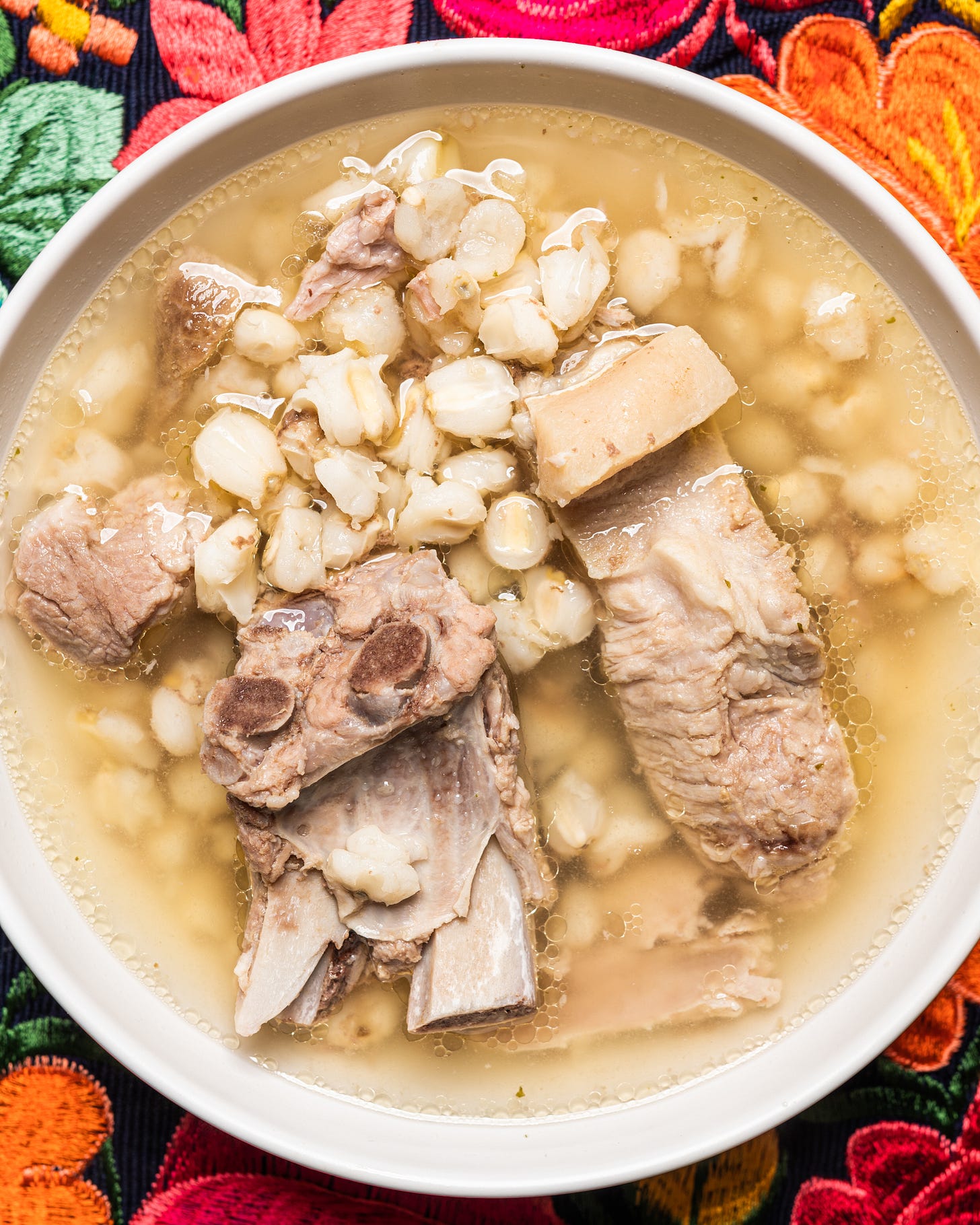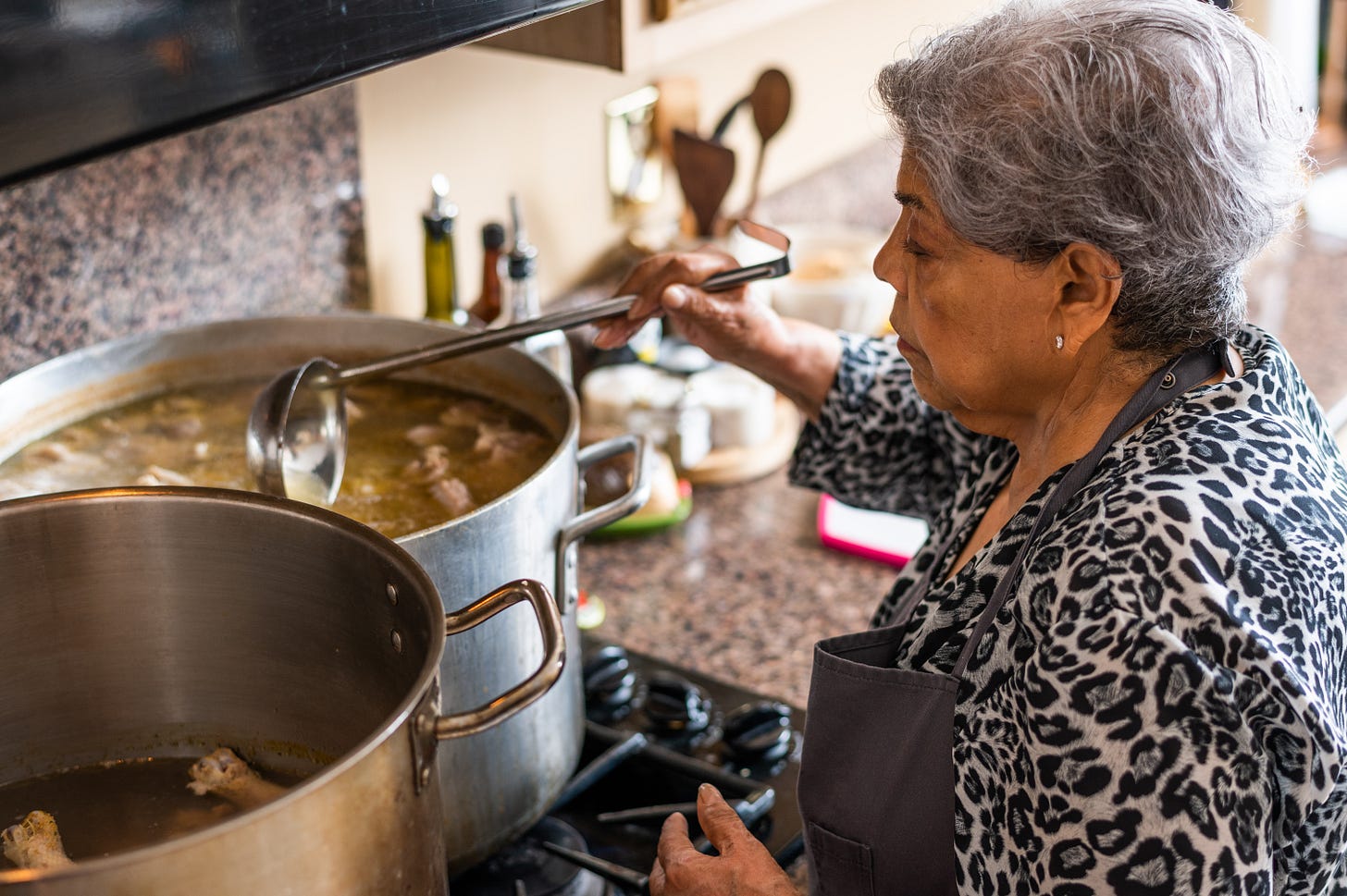Hi friends!
Rémy and I are settling back in after a week in Maine with her mom, where we gorged on many things, mostly lobster, raspberry pie, and fresh air. Admittedly, I’m not great at allowing myself to rest, and I had forgotten just how intimate learning to relax in front of a partner can be, but it was all very calm and refreshing and delicious. Turns out vacations are pretty great—who knew?! 10/10 would highly recommend.
Here’s what we came home to:
Cooking: Pozole (see feature below), leftovers from Sunday’s Good Trouble Network box, and mini pancake cereal, which is a real recipe that Rémy had to test this week for the coming TikTok cookbook.
Drinking: “The Spritz of Independence,” featuring local citrus wine (see recipe below).
Foraging: Mushrooms—chanterelles and morels, specifically—that were gifted by a friend who said she got them from her weed dealer.
Reading: Lolis Eric Elie’s “The Afterlives of ‘Creole Feast’” in The Bitter Southerner.
Listening to: “Chop It Up,” recorded last year by Mannie King & Aries de Artist for Froot Orleans, which recently announced it’s opening a new distribution center and cashless fruit stand.
Watching: Shapeless, a haunting story about an eating disorder that recently premiered at Tribeca Film Festival. Set in New Orleans, the film is written and executive produced by its lead actress, Kelly Murtagh, with lots of local talent supporting her in the credits.
Also watching: Highlight reels of Sha’Carri Richardson’s Olympic trials. On repeat.
Working on: A photo story on commercial crabbing in South Louisiana for a future issue of TBA.
Today we’re heading into the kitchen with Ana Castro, learning how to make pozole with her grandmother and talking about Lengua Madre, the restaurant she’s opening in August. We’ve also got an easy recipe for a July 4th-inspired spritz using local orange wine, and a fresh batch of lagniappe links to round things out.
A Day in the Kitchen with Ana Castro
Ana and I share a curiosity about the stories and traditions that can be passed down through food—family histories that are preserved through specific recipes and cooking techniques. The first time we met, Ana hugged me, and within minutes she was telling me about her grandmother, Lydia, describing her family's kitchen in Mexico City, and telling me how Lydia refuses to buy a lime at the store because she can reach through the window to grab one anytime she wants.
At that moment, I wanted to learn about Ana’s plans for her upcoming restaurant Lengua Madre, and she wanted to tell me about her grandmother’s influence on her cooking. During Lydia’s recent visit to New Orleans, I got to hear more about both.
Before we get to the pozole, here’s what I know about the restaurant: The space, formerly known as Thalia and more recently as Here Today, remains part of the Coquette family, but is now under Ana’s leadership. “It's going to be a personal interpretation of Mexican food,” Ana tells me. She says that she’s opening the space for herself, and not for Lydia, cooking food through a more autobiographical lens. But Ana notes, “Everything that I do, everything that I am, is an ode to my grandmother.”
Some of these plans may evolve before the doors open, but Ana tells me that the inside seating will feature a prix-fixe tasting menu, and outside tables will offer a few a la carte items. She says her team also has plans to offer a breakfast menu. There’s something for everyone, as Ana puts it, to “get in where you fit in.”
Behind the menus and decor, there’s a greater motivation:
“More romantically, I really want this space to be a chance to reevaluate where the relationships of Mexicans and Americans stand. I feel food is a great catalyst—a lot of conversations start around food—and I would love for this project to instill some empathy into people. Maybe, for one day, trying to put yourself in the shoes of someone else. How would you move through the world differently? How would the world treat you differently?”
Lengua Madre is slated to open in August, and is currently hiring team members! More details about the space and menu offerings will be announced in the coming weeks.
“Lydia’s Pozole for Ana”
One of the things that makes this recipe unique to Ana’s family is that the salsa is added to individual bowls, and not to the pot. “My grandmother cooks pozole this way,” Ana explains, “because I have a very low tolerance for spice. When she leaves the pozole base white, I can adjust the spice in the bowl, and so can everyone else in my family whose spice tolerance is waaaay higher than mine.”
This is the first time the recipe’s been written down, and Ana notes that it’s an adaptation from what she’s learned from Lydia. She’s provided an option for pork or chicken, but when I visited, her grandmother made both. Ana’s also outlined notes and resources for nixtamilizing corn at home—you can use store-bought hominy for an easier preparation, but this is part of a more traditional method for preparing pozole, and worth preserving with the family’s recipe.
Yield: A big pot.
Ingredients:
For the broth:
2 lbs. rack of pork*, cut into spare ribs
2 lbs. pork shoulder butt*—“country-style ribs”—cut into 2-inch cubes if you can hack through the bone/get your butcher to do it (if not, Ana says not to worry about it)
6 bay leaves
2 sprigs thyme
1/4 cup dried Mexican oregano
1 onion, peeled and cut in half
1 head garlic, peeled
2 Tbsps. salt
1 can hominy**—“the big one” (105 oz. / approx. 3 kilos), any brand but Goya because, “fuck ‘em”
2 Tbsps. chicken bouillon (Lydia likes Knorr brand)
* You can substitute the pork with 1 whole chicken.
** Or you can nixtamalize your own corn! See Ana’s notes below the recipe.
For the salsa:
250g (about 1/2 lb) dried arbol chiles
Enough water to cover the chiles halfway
3 cloves garlic
1 small white onion
1 Tbsp. salt + more to taste
For the garnish:
2 heads iceberg lettuce, shredded
500g (a little over 1 lb.) cherry belle (round) radishes, sliced thin with a knife or mandolin
12 limes, cut into wedges
3 large white onions, diced small
½ cup dried Mexican oregano
For the tostadas:
1 pint crema, crema de rancho, Honduran cream—“anything from the Latin market,” Ana says, “but please don’t use Daisy sour cream. If you are feeling fancy, make crème fraîche.”
1 lb. fresh cheese—“Ideal Market sells cuajada. It’s as close as we will get to the real thing my grandma likes to use.”
As many tostadas as your heart desires. “Get ‘em from Mawi NOLA if you can. Very well worth the drive.”
Valentina Hot Sauce, to taste
Preparation:
For the broth:
Rinse the hominy in a colander over the sink and set aside.
Place the pork or chicken in a large pot with the bay leaves, thyme, oregano, onion, garlic, and about 2 tablespoons of salt. Cover with water and bring to a boil, then reduce the heat to a light simmer, skimming off any impurities that foam up. Once the top of the pot is “clean,” remove the onion and garlic and add the hominy. Continue cooking for at least 1 hour. For pork: Cook until the meat is tender and falling off the bone. For chicken: Simmer until cooked thoroughly, then remove the bird, pick the carcass and add the meat back to the broth. Once the protein is ready, adjust seasoning with salt and chicken bouillon. (“Only if you're into that,” Ana says. “I know my grandma is.”)
The meat can be cooked a day ahead and stored in a bit of cooking liquid so it doesn't dry out. If using chicken, Ana suggests pulling all of the meat before storing.
For the salsa:
Quickly toast the arbol chiles in a pan, and be careful to not let them burn or turn black or they’ll become bitter. Transfer to a pot, add enough water to cover halfway, then simmer. Once the water has evaporated by half, transfer the chiles to a blender. Add the onion, garlic and salt, and blend to a smooth consistency. NOTE: Do not immediately open the blender! Allow the chile steam to rest for 5 minutes. Once settled, transfer the salsa to a couple bowls for the table. Ana says you can freeze any extra chile base for months, or keep it in the fridge for up to 1 month and use it as a base for other stews.
Garnish checklist:
Divide each into 2-3 bowls, depending on the length of your table.
Shredded lettuce
Shaved radishes
Lime wedges
Diced onion
Oregano
Chile de arbol salsa
Tostadas
Crema
Cheese
Valentina Hot Sauce
To serve:
Ladle the pozole into bowls with plenty of hominy and as much meat as every guest desires, then build it as follows:
Add a small spoonful of salsa, then stir and adjust to individual spice preference. Ana encourages you to work in small increments,” as it’s very potent. “You have been warned!”
Add lime. “I like my food bright,” she says. “So I always go heavy on this step!”
Add a spoonful of diced onion.
Add a handful of shredded lettuce.
Top with shaved radishes—as many as you like!
For the oregano, Ana instructs to “grab a fat pinch and crush it over your bowl using the palm of your hands.”
Mix all the layers together with a spoon and enjoy!
After a couple spoonfuls, grab a tostada and spread some crema on it. On top of the crema, sprinkle an even layer of cheese, and (optional) add a drizzle or two of Valentina. “Take a bite from your tostada,” Ana says, “then a spoonful of pozole. Alternate as often as you want for a texture contrast!”
Pair with a light beer. “If ya’ can,” she says, “make it a Mexican one. I like Modelo with my pozole.”
Nixtamalization at Home
As an alternative to hominy, you can buy cacahuazintle corn and nixtamalize it for your pozole. Ana says, “I source mine from Masienda. They sell a pozole starter kit that is pretty solid—it contains the cacahuazintle corn, culinary lime, and there's an option to add on a booklet on nixtamalization that I highly recommend.” You’ll want to prepare this a day before you cook your pozole.
“When nixtamalizing the corn,” Ana says, “I cook my protein and my hominy separately, because I do not possess the tactile intelligence my grandma has to guesstimate how long the corn will take to cook in comparison to the meat. Since I don't want to overcook the meat and undercook the corn or the other way around, I keep the processes separate—but if you're up for a challenge, I salute you!”
Start by rinsing the corn and removing any kernels that are discolored or broken. Per Ana, “Masienda is badass and excellent quality, so there may be very few impurities.” Weigh the rinsed corn, then measure out 1% of its weight in culinary lime (cal). Whisk the cal in 1 cup of water and set aside. Place the corn in a non-reactive pot, add enough water to cover it by roughly 2 1/2 inches, then bring almost to boiling and add in the cal mixture. Cook at a medium-high heat for about an hour, or until you can rub the skin off a kernel with your fingers. Remove the pot from the stove and let it sit at room temperature for a couple hours, then transfer to the fridge. Let it rest overnight in the cooking liquid (nejayote).
The next day, rinse the corn in a colander and remove the pericarp (the hard outer layer) of the kernels. Prepare the pork or chicken following the steps above, but once cooked through, pull the meat from the broth and set aside. Gently cook the rinsed corn in the stock for at least an hour and a half, occasionally testing a kernel, until you’ve reached the desired consistency (fully hydrated/bloomed, with no remnants of uncooked starch—nice and tender!) Adjust the broth with salt and bouillon as noted in the recipe above. Add the meat back to the pot and adjust seasoning again, if needed.
Recipe: The Spritz of Independence
A few weeks back, 64 Parishes published an article from the magazine’s summer issue on orange wine—not the trendy, tinted-from-skin-contact kind of orange wine, but the kind made from actual citrus. I’ve since heard a few stories from locals with memories of a sweet wine that used to be sold from the side of the road and led to many a hangover, but the article highlighted the state’s only commercial producer: Amato’s, located just across the lake in Independence, Louisiana.
I found several of Amato’s fruit wine offerings at Total Wine in Metairie, including the orange, but also blackberry and strawberry. They’re sweet, so Rémy and I chilled a bottle and used it as a base for an easy summer bev. Behold: The Spritz of Independence.
2 oz. Amato’s orange wine
1/2 oz. fresh lemon juice
3 dashes Peychaud’s bitters
3-4 oz. lemon seltzer
Lemon wheel, for garnish
Lagniappe
Sue Zemanick of Zasu collaborated with Phish on Tuesday, providing recipes for the last of the band’s virtual “Dinner And A Movie” series.
Ian McNulty reports that Ms. Linda Green (AKA The Yakamein Lady) has a pop-up at the uptown Rouses every Sunday, from 11:00 a.m. - 3:00 p.m.
Dong Phuong Bakery has ditched its logo and colorful packaging in response to a legal battle with the Austin-based firm that designed them.
Brennan’s Restaurant reclaimed recognition as a Wine Spectator Grand Award winner, an honor the restaurant won annually from 1983 until 2005, when Hurricane Katrina destroyed its wine cellar. A recent episode of Jeopardy also gave a nod to the restaurant for its famed Bananas Foster dessert.
Melvin Rogers Stovall III (AKA Mel at Midnight) announced a return to New Orleans with the launch of liberté, which is hosting a five-course vegan dinner on July 23.
Gambit recently interviewed Abby Boone about the ice cream company she and her husband Aaron started last year, early in the pandemic. Lucy Boone Ice Cream was one of the businesses that made up Here Today in the Lower Garden District.
Tory McPhail (formerly of Commander’s Palace) was crowned King of Kings at the 2021 Louisiana Seafood Cook-Off.
Local bladesmith Ty Tonelli just re-stocked Coutelier with a fresh batch of Dewclaw knives.
In non-food news: Jazz Fest announced its lineup! And Dirty Coast released a new shirt to commemorate the still-unidentified animal remains that were spilled onto Tchoupitoulas last week. Lastly, Marsh Dog, a local business that made dog treats from nutria, closed during the pandemic but was recently acquired by Minnesota-based pet food maker Chasing Our Tails.
See y’all in two weeks!
Thanks to Ana and her family for hosting and generously sharing their food and history, and thanks to all of y’all for reading and for supporting local food businesses.












